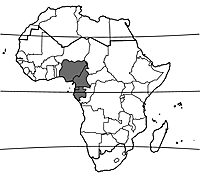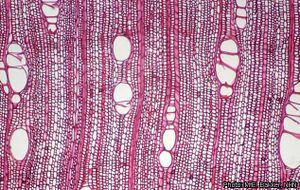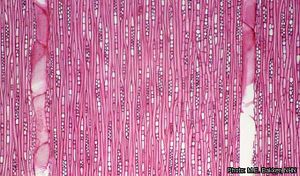Cyrtogonone argentea (PROTA)
Introduction |
| General importance | |
| Geographic coverage Africa | |
| Geographic coverage World | |
| Fruit | |
| Medicinal | |
| Timber | |
| Food security | |
Cyrtogonone argentea (Pax) Prain
- Protologue: Bull. Misc. Inform. Kew 1911: 232 (1911).
- Family: Euphorbiaceae
Origin and geographic distribution
Cyrtogonone argentea occurs from eastern Nigeria to Gabon.
Uses
The wood, known as ‘akikubu’ in Cameroon, is used for general carpentry, joinery and furniture. The seeds are eaten, often together with sauce made from fruit kernels of Irvingia gabonensis (Aubry-Lecomte ex O’Rorke) Baill. The grated bark, mixed with sugar-cane juice and cooked with palm cabbage or groundnuts, is taken against stomach-ache. It has an acrid taste and is strongly purgative. In western Cameroon unspecified parts of the plant are used as anodyne.
Properties
The wood is reddish white to pale brown. The texture is fine, and the wood is moderately hard and not durable. Roots of Nigerian material have been found very effective as a molluscicide giving 100% mortality against the fresh-water snail Bulinus globatus at an extract concentration of 100 ppm; leaf extracts showed no activity. Extracts of the leaf, stem and fruit showed significant activity in a phorbol dibutyrate receptor binding assay, indicating that the extracts have tumour promoting properties.
Description
- Dioecious, medium-sized tree up to 30(–35) m tall; bole often fluted at base, up to 35 cm in diameter; bark surface greyish brown to dark brown, smooth to rough with horizontal lines, inner bark granular, brown, with yellow innermost layer; twigs densely silvery scaly.
- Leaves alternate, simple; stipules minute; petiole 6–10 cm long, with 2 distinct glands at the apex; blade elliptical or obovate-oblong, sometimes deeply 3-lobed, 15–35 cm × 7.5–12.5(–30) cm, base cuneate to rounded, apex abruptly acuminate, margin entire or occasionally with 2 teeth or minute lobes near the apex, leathery, densely silvery scaly below, pinnately veined.
- Inflorescence a terminal, narrowly pyramidal panicle up to 30 cm long, scaly, with many branches up to 7.5 cm long, with 3–7-flowered cymes.
- Flowers unisexual, regular, pedicel up to 5 mm long; male flowers with globose calyx in bud, up to 8 mm in diameter, at flowering irregularly (2–)3(–4)-lobed, densely scaly, petals 5(–6), free, orbicular, contorted, glabrous, white, stamens about 30, free, glabrous, disk glands many; female flowers with 4–5-lobed calyx, petals as in male flowers, disk shallowly cup-shaped, ovary superior, 3-celled, with 2-fid styles.
- Fruit a 3-lobed capsule up to 5 cm in diameter, brown hairy, splitting into 3 parts, each 2-valved and 1-seeded.
- Seeds globose.
Other botanical information
In Nigeria trees flower in May and mature fruits can be found in July–September.
Cyrtogonone comprises a single species and seems to be closely related to Crotonogyne and Manniophyton.
Ecology
Cyrtogonone argentea occurs in evergreen rainforest, often in secondary forest, up to 1000 m altitude.
Genetic resources
Although Cyrtogonone argentea is restricted to rainforest and has a limited area of distribution, it seems to be quite common in most of its distribution area, and does not seem to be threatened at present.
Prospects
Cyrtogonone argentea is likely to remain of local use only, unless research on this poorly known species would reveal new opportunities.
Major references
- Burkill, H.M., 1994. The useful plants of West Tropical Africa. 2nd Edition. Volume 2, Families E–I. Royal Botanic Gardens, Kew, Richmond, United Kingdom. 636 pp.
- Normand, D. & Paquis, J., 1976. Manuel d’identification des bois commerciaux. Tome 2. Afrique guinéo-congolaise. Centre Technique Forestier Tropical, Nogent-sur-Marne, France. 335 pp.
- Radcliffe-Smith, A., 2001. Genera Euphorbiacearum. Royal Botanic Gardens, Kew, United Kingdom. 455 pp.
- Raponda-Walker, A. & Sillans, R., 1961. Les plantes utiles du Gabon. Paul Lechevalier, Paris, France. 614 pp.
- Wilks, C. & Issembé, Y., 2000. Les arbres de la Guinée Equatoriale: Guide pratique d’identification: région continentale. Projet CUREF, Bata, Guinée Equatoriale. 546 pp.
Other references
- Anonymous, 2001. Management plan of the Nta Ali Forest Reserve. Ministère de l’Environnement et des Forêts, Republique du Cameroun, Yaounde, Cameroon. 18 pp.
- Beutler, J.A., Alvarado, A.B., McCloud, T.G. & Cragg, G.M., 2006. Distribution of phorbol ester bioactivity in the Euphorbiaceae. Phytotherapy Research 3(5): 188–192.
- Brown, N.E., Hutchinson, J. & Prain, D., 1909–1913. Euphorbiaceae. In: Thiselton-Dyer, W.T. (Editor). Flora of tropical Africa. Volume 6(1). Lovell Reeve & Co., London, United Kingdom. pp. 441–1020.
- Keay, R.W.J., 1989. Trees of Nigeria. A revised version of Nigerian trees (1960, 1964) by Keay, R.W.J., Onochie, C.F.A. & Stanfield, D.P. Clarendon Press, Oxford, United Kingdom. 476 pp.
- Neuwinger, H.D., 2000. African traditional medicine: a dictionary of plant use and applications. Medpharm Scientific, Stuttgart, Germany. 589 pp.
- Sunderland, T.C.H., 2005. A biodiversity assessment of the Monte Mitra forest, Monte Alen National Park, Equatorial Guinea. Smithsonian Institution, Washington, United States. 83 pp.
- Van der Veen, L.J. & Bodinga bwa Bodinga, S., undated. Une société traditionnelle noire africaine et ses plantes utiles : les Éviya du Gabon. Dénomination, catégorisation et utilisation des plantes. [Internet] Editions Raponda-Walker, Libreville, Gabon. 140 pp. http://www.ddl.ish-lyon.cnrs.fr/ fulltext/Van%20der%20Veen/ Van%20der%20Veen_%C3%A0%20para%C3%AEtre_a.pdf. January 2011.
- van Welzen, P.C. & Stuppy, W., 1999. Phylogenetic considerations of Euphorbiaceae tribe Aleuritideae. Annals of the Missouri Botanical Garden 86(4): 894–903.
- Westra, L.Y.T. & Koek-Noorman, J., 2004. Wood Atlas of the Euphorbiaceae. IAWA Journal Supplement 4. IAWA & National Herbarium, Leyden, Netherlands. 110 pp.
Author(s)
- L.P.A. Oyen, PROTA Network Office Europe, Wageningen University, P.O. Box 341, 6700 AH Wageningen, Netherlands
Correct citation of this article
Oyen, L.P.A., 2011. Cyrtogonone argentea (Pax) Prain. [Internet] Record from PROTA4U. Lemmens, R.H.M.J., Louppe, D. & Oteng-Amoako, A.A. (Editors). PROTA (Plant Resources of Tropical Africa / Ressources végétales de l’Afrique tropicale), Wageningen, Netherlands.
Accessed 22 December 2024.
- See the Prota4U database.



